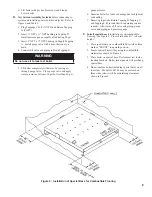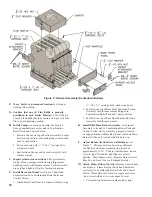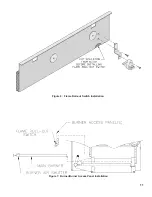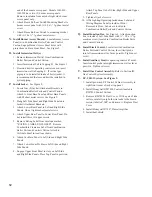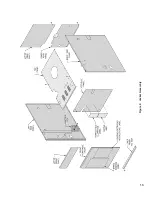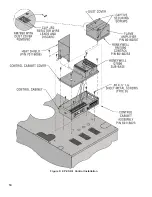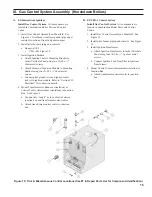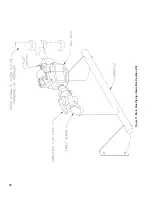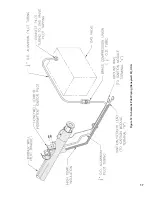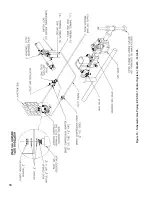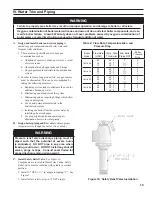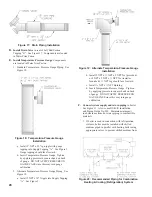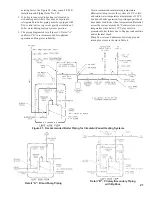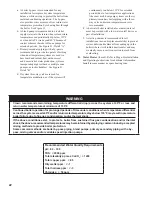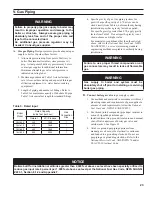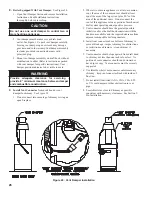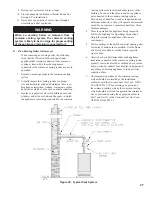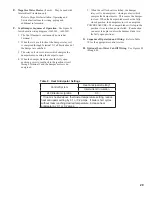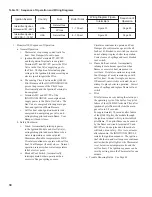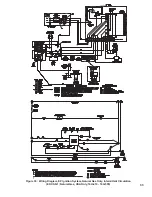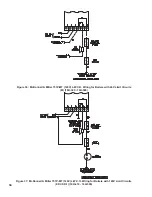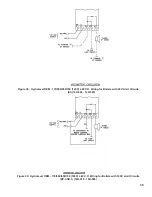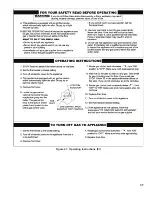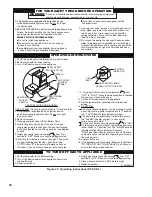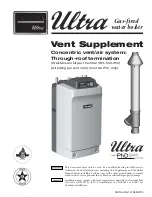
23
V. Gas Piping
WARNING
Failure to properly pipe gas supply to boiler may
result in improper operation and damage to the
boiler or structure. Always assure gas piping is
absolutely leak free and of the proper size and
type for the connected load.
An additional gas pressure regulator may be
needed. Consult gas supplier.
A.
Size gas Piping.
Design system to provide adequate gas
supply to boiler. Consider these factors:
1. Allowable pressure drop from point of delivery to
boiler. Maximum allowable system pressure is ½
psig. Actual point of delivery pressure may be less;
contact gas supplier for additional information.
Minimum allowable gas valve inlet pressure is
indicated on rating label.
2. Maximum gas demand. Table 5 lists boiler input
rate. Also consider existing and expected future gas
utilization equipment (i.e. water heater, cooking
equipment).
3. Length of piping and number of fittings. Refer to
Table 6 for maximum capacity of Schedule 40 pipe.
Table 7 lists equivalent length for standard fittings.
Boiler
Model
Rated Capacity
(cubic feet per hour)
Gas
Connection
Size
Natural
LP / Propane
16H-340
340
136.0
1
16H-410
410
164.0
1
16H-460
460
184.0
1
16H-505
505
202.0
1
Table 5: Rated Input
4. Specific gravity of gas. Gas piping systems for
gas with a specific gravity of 0.70 or less can be
sized directly from Table 6, unless authority having
jurisdiction specifies a gravity factor be applied.
For specific gravity greater than 0.70, apply gravity
factor from Table 8. If exact specific gravity is not
shown choose next higher value.
For materials or conditions other than those listed
above, refer to the
National Fuel Gas Code
, NFPA
54/ANSI Z223.1, or size system using standard
engineering methods acceptable to authority having
jurisdiction.
WARNING
Failure to use proper thread compounds on all
gas connectors may result in leaks of flammable
gas.
WARNING
Gas supply to boiler and system must be
absolutely shut off prior to installing or servicing
boiler gas piping.
B.
Connect boiler gas valve
to gas supply system.
1. Use methods and materials in accordance with local
plumbing codes and requirements of gas supplier. In
absence of such requirements, follow the
National
Fuel Gas Code
, NFPA 54/ANSI Z223.1
2. Use thread (joint) compound (pipe dope) resistant to
action of liquefied petroleum gas.
3. Install sediment trap, ground-joint union and manual
shut-off valve upstream of boiler gas valve and
outside jacket. See Figure 22.
4. All above ground gas piping upstream from
manual gas valve must be electrically continuous
and bonded to a grounding electrode. Do not use
gas piping as a grounding electrode. Refer to the
National Electrical Code
, ANSI/NFPA 70 and/or
CSA C22.1 Electrical Code.
NOTICE
Boilers built for installation at altitudes greater than 2,000 feet above sea level have been specially orificed to
reduce gas input rate 4 percent per 1,000 feet above sea level per the National Fuel Gas Code, NFPA 54/ANSI
Z223.1, Section 8.1.2 and Appendix F.
Содержание 16H-340
Страница 11: ...11 Figure 6 Flame Roll out Switch Installation Figure 7 Burner Burner Access Panel Installation ...
Страница 13: ...13 Figure 8 Jacket Assembly ...
Страница 14: ...14 Figure 9 EP CSD 1 Control Installation ...
Страница 16: ...16 Figure 11 Main Gas Piping Intermittent Ignition EI ...
Страница 17: ...17 Figure 12 Schematic Pilot Piping Honeywell EI USA ...
Страница 18: ...18 Figure 15 Schematic Gas Piping EP CSD 1 Control System 16H 410 16H 505 ...
Страница 31: ...31 Figure 31 Wiring Diagram Honeywell EI USA Intermittent Circulation 16H 340 16H 510 MegaStor Relay MegaStor ...
Страница 37: ...37 Figure 41 Operating Instructions EI ...
Страница 47: ...47 Honeywell EI Trouble Shooting Guide ...
Страница 48: ...48 THIS PAGE LEFT BLANK INTENTIONALLY ...
Страница 58: ...58 ...
Страница 60: ...60 ...

